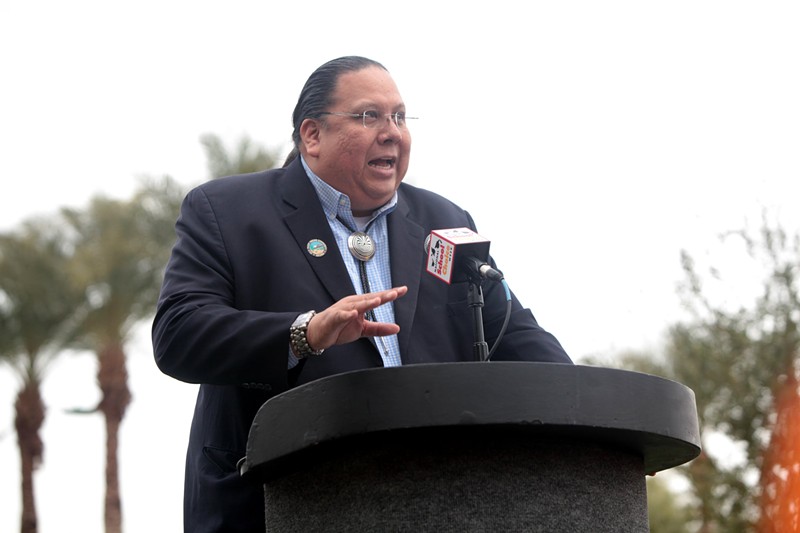In a major step forward for Arizona's Drought Contingency Plan negotiations, the Gila River Indian Community Council voted unanimously Wednesday in favor of a deal to supply water to the Central Arizona Groundwater Replenishment District.
Under the deal, the Gila River Indian Community would supply the district, often referred to as CAGRD, with up to 830,000 acre-feet of desperately needed water over the next 25 years, starting in 2020. The board of the Central Arizona Project, which governs CAGRD, approved the deal in a meeting at the beginning of November.
The deal would help ensure that developers in Arizona can continue to build well into the future. (The question of whether that should happen is a debate for another day.)
“We believe our action today helps build momentum to have Arizona approve DCP and protect Lake Mead, but at the same time ensure that water supplies are available for an important sector of Arizona’s economy," Gila River Indian Community Govenor Stephen Roe Lewis said in a statement Wednesday.
But, in a strategic move as DCP negotiations continue, Lewis has not yet signed the deal between the Gila River Indian Community and CAGRD.
That moment will have to wait until Arizona's DCP is passed by the Arizona Legislature and signed by the state. In other words, if the DCP doesn't happen, neither does the CAGRD deal.
Lewis alluded to this contingency in his statement Wednesday, as he explained how the negotiations for the CAGRD deal had proceeded in recent months.
"The Community had been very concerned that DCP might not happen and was re-examining whether these
agreements were the best use of our water supplies in times of shortage," he said. "As a result, we had
been waiting to see whether DCP was a realistic possibility or whether we should wait and perhaps move in a different direction."
In the contentious world of Arizona water politics, the CAGRD deal is closely linked with ongoing DCP discussions, in which Arizona water users are working out how they’ll distribute expected cuts in the state’s supply of Colorado River water.
Holding off on signing the CAGRD deal helps leave it in place as incentive to key stakeholders — namely, the Central Arizona Project — to agree on and approve a DCP.
Terry Goddard, who sits on the Central Arizona Project board, called the CAGRD agreement a “pretty damn good deal for the development community.”
Prior to the deal, CAGRD was “really scrambling to get future supplies,” Goddard said. With the deal, “it would be in a net positive for the next 25 years,” even if a shortage is declared on the Colorado River.
In its meeting at the beginning of November, when DCP talks were faltering, the Community Council tabled a decision on the CAGRD deal, precisely because those talks seemed to be going nowhere.
If no DCP was worked out, the deal would be reconfigured, in order to adjust to the Community’s concerns about water supplies, Don Pongrace, an attorney for the Community, said at the time. He warned that the deal was “in substantial jeopardy” because of “the lack of negotiations.”
But by late November, after packed weeks of private diplomacy, negotiators had worked out a DCP proposal that most stakeholders deemed imperfect but workable. Suddenly, the CAGRD deal was back on the table.
If signed, the deal would cost the Central Arizona Project $97.5 million up front. Over the next 25 years, total costs could reach $310.8 million (in 2018 dollars), depending on if — or more likely, when — a shortage is declared on the Colorado River.
Under the deal, Gila River Water Storage, a water-storage company formed jointly by the Gila River Indian Community and Salt River Project, will sell 445,375 acre-feet of long-term storage credits to CAGRD. An acre-foot is roughly 326,000 gallons.
Long-term storage credits are crucial to CAGRD, an entity that helps developers meet requirements under the 1980 Groundwater Management Act to show that their water supply is secure for at least the next 100 years. If developers don’t have 100 years’ worth of water wherever they’re developing, they can enroll in CAGRD and gain access to this future supply.
They can do this because of long-term storage credits. Water users earn these credits when they store water underground for more than a year. The credits, which can be transferred, give whoever holds them the right to recover that water in the future.
Without the deal with the Gila River Indian Community, if a drought were declared on the Colorado River, CAGRD’s supply of long-term storage credits for Phoenix is project to hit a shortage in the year 2028 and to run out completely by 2030.
With the deal, CAGRD would have enough water to meet all of its obligations, even if there is a shortage on the Colorado River. Based on current environmental conditions, the federal Bureau of Reclamation projects that a shortage has a 57 percent chance of occurring in the year 2020.
The deal also creates a way for the Gila River Indian Community and CAGRD to swap supplies of water stored underground with surface water from the Colorado River. The infrastructure for that exchange would cost $2.5 million. The deal allows CAGRD to lease Colorado River water from the Gila River Indian Community.
The Central Arizona Project plans to pay for this plan by increasing the cost of water deliveries in Phoenix and potentially in Tucson.
Starting in 2020, rates would increase 11 to 15 percent over the next two or three years. That translates to a total average increase of $3.11 per month, per home, by the end of the third year. After that, the impact on rates would be “small,” according to CAP.
In Tucson, rates would remain the same or stay close to their published schedule.
[
{
"name": "Air - MediumRectangle - Inline Content - Mobile Display Size",
"component": "18478561",
"insertPoint": "2",
"requiredCountToDisplay": "2",
"watchElement": ".fdn-content-body",
"astAdList": [
{
"adType": "rectangle",
"displayTargets": "mobile"
}
]
},{
"name": "Editor Picks",
"component": "16759093",
"insertPoint": "4",
"requiredCountToDisplay": "1",
"watchElement": ".fdn-content-body",
"astAdList": [
{
"adType": "rectangle",
"displayTargets": "desktop|tablet"
},{
"adType": "rectangle",
"displayTargets": "desktop|tablet|mobile"
}
]
},{
"name": "Inline Links",
"component": "17980324",
"insertPoint": "8th",
"startingPoint": 8,
"requiredCountToDisplay": "7",
"maxInsertions": 25
},{
"name": "Air - MediumRectangle - Combo - Inline Content",
"component": "16759092",
"insertPoint": "8th",
"startingPoint": 8,
"requiredCountToDisplay": "7",
"maxInsertions": 25,
"watchElement": ".fdn-content-body",
"astAdList": [
{
"adType": "rectangle",
"displayTargets": "desktop|tablet"
},{
"adType": "rectangle",
"displayTargets": "desktop|tablet|mobile"
}
]
},{
"name": "Inline Links",
"component": "17980324",
"insertPoint": "8th",
"startingPoint": 12,
"requiredCountToDisplay": "11",
"maxInsertions": 24
},{
"name": "Air - Leaderboard Tower - Combo - Inline Content",
"component": "16759094",
"insertPoint": "8th",
"startingPoint": 12,
"requiredCountToDisplay": "11",
"maxInsertions": 24,
"watchElement": ".fdn-content-body",
"astAdList": [
{
"adType": "leaderboardInlineContent",
"displayTargets": "desktop|tablet"
},{
"adType": "tower",
"displayTargets": "mobile"
}
]
}
]











